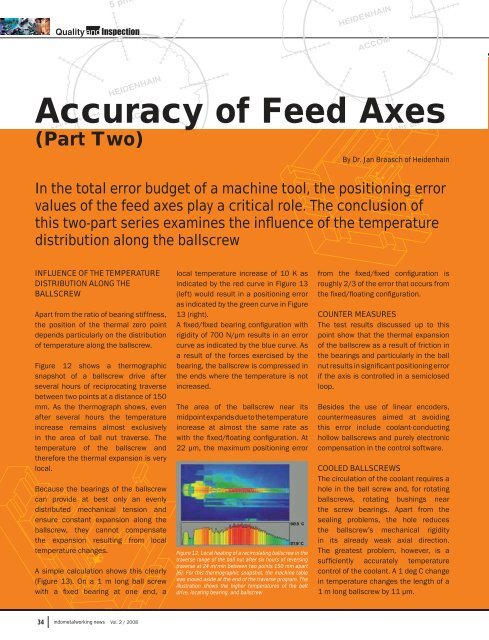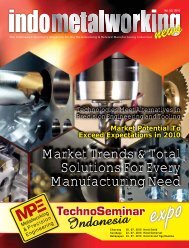High Speed Machining Precision Tooling - Indobiz.biz
High Speed Machining Precision Tooling - Indobiz.biz
High Speed Machining Precision Tooling - Indobiz.biz
Create successful ePaper yourself
Turn your PDF publications into a flip-book with our unique Google optimized e-Paper software.
Accuracy of Feed Axes<br />
(Part Two)<br />
By Dr. Jan Braasch of Heidenhain<br />
In the total error budget of a machine tool, the positioning error<br />
values of the feed axes play a critical role. The conclusion of<br />
this two-part series examines the influence of the temperature<br />
distribution along the ballscrew<br />
INFLUENCE OF THE TEMPERATURE<br />
DISTRIBUTION ALONG THE<br />
BALLSCREW<br />
Apart from the ratio of bearing stiffness,<br />
the position of the thermal zero point<br />
depends particularly on the distribution<br />
of temperature along the ballscrew.<br />
Figure 12 shows a thermographic<br />
snapshot of a ballscrew drive after<br />
several hours of reciprocating traverse<br />
between two points at a distance of 150<br />
mm. As the thermograph shows, even<br />
after several hours the temperature<br />
increase remains almost exclusively<br />
in the area of ball nut traverse. The<br />
temperature of the ballscrew and<br />
therefore the thermal expansion is very<br />
local.<br />
Because the bearings of the ballscrew<br />
can provide at best only an evenly<br />
distributed mechanical tension and<br />
ensure constant expansion along the<br />
ballscrew, they cannot compensate<br />
the expansion resulting from local<br />
temperature changes.<br />
A simple calculation shows this clearly<br />
(Figure 13). On a 1 m long ball screw<br />
with a fi xed bearing at one end, a<br />
local temperature increase of 10 K as<br />
indicated by the red curve in Figure 13<br />
(left) would result in a positioning error<br />
as indicated by the green curve in Figure<br />
13 (right).<br />
A fi xed/fi xed bearing confi guration with<br />
rigidity of 700 N/μm results in an error<br />
curve as indicated by the blue curve. As<br />
a result of the forces exercised by the<br />
bearing, the ballscrew is compressed in<br />
the ends where the temperature is not<br />
increased.<br />
The area of the ballscrew near its<br />
midpoint expands due to the temperature<br />
increase at almost the same rate as<br />
with the fi xed/fl oating confi guration. At<br />
22 μm, the maximum positioning error<br />
Figure 12. Local heating of a recirculating ballscrew in the<br />
traverse range of the ball nut after six hours of reversing<br />
traverse at 24 m/min between two points 150 mm apart<br />
[6]. For this thermographic snapshot, the machine table<br />
was moved aside at the end of the traverse program. The<br />
illustration shows the higher temperatures of the belt<br />
drive, locating bearing, and ballscrew<br />
from the fi xed/fi xed confi guration is<br />
roughly 2/3 of the error that occurs from<br />
the fi xed/fl oating confi guration.<br />
COUNTER MEASURES<br />
The test results discussed up to this<br />
point show that the thermal expansion<br />
of the ballscrew as a result of friction in<br />
the bearings and particularly in the ball<br />
nut results in signifi cant positioning error<br />
if the axis is controlled in a semiclosed<br />
loop.<br />
Besides the use of linear encoders,<br />
countermeasures aimed at avoiding<br />
this error include coolant-conducting<br />
hollow ballscrews and purely electronic<br />
compensation in the control software.<br />
COOLED BALLSCREWS<br />
The circulation of the coolant requires a<br />
hole in the ball screw and, for rotating<br />
ballscrews, rotating bushings near<br />
the screw bearings. Apart from the<br />
sealing problems, the hole reduces<br />
the ballscrew’s mechanical rigidity<br />
in its already weak axial direction.<br />
The greatest problem, however, is a<br />
suffi ciently accurately temperature<br />
control of the coolant. A 1 deg C change<br />
in temperature changes the length of a<br />
1 m long ballscrew by 11 μm.<br />
34<br />
indometalworking news Vol. 2 / 2008




